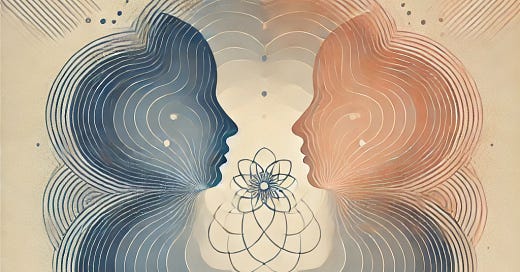In the realms of psychology and spirituality, the dark side of our persona is often shunned or feared, associated with shadows and aspects of ourselves we try to hide. However, Mother Night by Clarissa Pinkola Estés sheds light on the necessity of confronting and accepting the dark feminine. Estés, a Jungian psychoanalyst and storyteller, takes readers on a journey through myth and narrative, illustrating that the hidden, darker aspects of the self are not to be feared, but to be embraced for deeper personal transformation.
The Inspiration Behind Mother Night
Clarissa Pinkola Estés is best known for her landmark work, Women Who Run with the Wolves, but Mother Night delves deeper into a particular aspect of the feminine psyche—what she refers to as the “night mother” or “dark mother.” Estés’ upbringing in a community that valued oral storytelling traditions had a profound impact on her work. The tales of the “wild woman,” passed down through generations, shaped her understanding of the deep, instinctual nature that women possess.
Estés wrote Mother Night to address the often neglected “shadow” side of femininity—the darkness that holds secrets of creation, destruction, and transformation. She draws from Jungian psychology’s concept of the shadow, the hidden and repressed aspects of our personality. For women, the dark feminine is an essential but neglected force, one that connects us to the cycles of life and death, loss and renewal.
The Dark Side of the Persona
The persona, in Jungian terms, is the mask we present to the world—the outward face we use to navigate society. Behind this mask lies the shadow, made up of the aspects of ourselves we have rejected or suppressed, often because they do not conform to societal norms. For many women, the dark side of the persona is often associated with qualities society deems “unacceptable”—anger, sensuality, ambition, and even vulnerability.
In Mother Night, Estés explores how the feminine shadow often contains the parts of ourselves that have been silenced. These include the raw, instinctual energies that are wild, creative, destructive, and nurturing all at once. The “dark mother” archetype, as presented by Estés, symbolizes the part of the feminine that holds this hidden power, guiding us through the depths of loss, death, and rebirth.
The Importance of Identifying the Shadow
Identifying our shadow involves recognizing the parts of ourselves we tend to deny or repress. Estés’ work encourages women to explore the feelings and desires they have buried—whether due to societal expectations, fear of judgment, or internalized beliefs about what it means to be “feminine.”
In Mother Night, Estés offers stories and metaphors that mirror this process. One example is the tale of the Night Mother, a figure who, though terrifying at first, becomes a source of wisdom and comfort once understood. She represents the force that leads us into our own emotional and psychological darkness, only to guide us toward transformation.
In the modern world, the dark feminine might show up as feelings of guilt for expressing anger, or shame for wanting more autonomy and power. Estés argues that these feelings are often a reflection of our disconnection from the darker aspects of the feminine psyche. By reclaiming these parts, we are not embracing negativity but tapping into a source of inner strength that is rooted in authenticity.
How to Accept the Shadow
Accepting the shadow requires patience, self-compassion, and a willingness to sit with discomfort. Estés’ approach is gentle yet powerful—she emphasizes that the process is one of integration, not eradication. We do not need to conquer the shadow; we need to bring it into the light of consciousness.
Here are a few key steps inspired by Estés' work to identify and accept the dark feminine within:
Self-Reflection: Take time to reflect on the emotions, behaviors, or desires you tend to suppress. Journaling or meditative practices can help bring awareness to the parts of yourself that have been hidden.
Embrace Anger and Grief: Estés highlights that the dark feminine is not only about creativity but also about destruction. Emotions like anger and grief are part of the natural cycle of life and can be powerful forces for change when expressed constructively.
Myth and Storytelling: Use stories to understand the shadow. Estés’ use of myth and folklore shows us that the dark mother archetype exists across cultures and serves as a reminder that embracing the shadow is part of the human experience.
Creative Expression: Engage in creative outlets—art, dance, writing—that allow you to express aspects of your personality you may not have given space to. The dark feminine thrives in creative expression, where chaos and order blend to produce something transformative.
Seek Depth in Relationships: Often, our shadow shows up most vividly in our relationships. Use these moments to reflect on what parts of yourself are being triggered. Rather than reacting defensively, try to understand what your shadow might be trying to tell you.
Comparison with Other Works: Mother Night vs. Women Who Run with the Wolves
While Women Who Run with the Wolves explores the instinctual, wild feminine, Mother Night focuses more on the darker, shadowy aspects of the feminine. In Women Who Run with the Wolves, the emphasis is on reclaiming the "wild woman" archetype and reconnecting with the deep, intuitive wisdom that comes from nature. The wild woman is bold, fierce, and unapologetic, helping women break free from societal constraints.
Mother Night, on the other hand, deals with the feminine forces of destruction and creation that are hidden in the night, in the shadow. It focuses on the cycles of death and rebirth, loss and renewal, and how these are essential aspects of a woman’s psyche. The dark feminine is less about instinct and more about mystery—about the deeper, transformative powers that are often misunderstood or feared.
The Healing Power of the Dark Feminine
At its core, Mother Night is about embracing the unknown. Estés encourages us to see the dark feminine not as something to be feared, but as a guiding force that can lead us through our most challenging experiences. In identifying and accepting the shadow, we open ourselves up to a more complete, authentic version of who we are.
The healing power of the dark feminine lies in its ability to transform pain into wisdom, anger into clarity, and fear into strength. When we allow ourselves to enter the night—both literally and metaphorically—we can emerge renewed, having integrated the parts of ourselves that hold the key to deeper self-understanding and fulfillment.
Takeaway
Clarissa Pinkola Estés’ Mother Night is a profound exploration of the dark feminine, offering readers a path toward integrating the shadow side of their persona. By identifying and accepting the parts of ourselves we’ve been conditioned to hide, we allow for greater healing and personal transformation. The stories and metaphors Estés shares help us navigate the complexity of the feminine psyche, illuminating the power that lies within the darkness.
References:
Estés, C. P. (1997). Mother Night: Myths, Stories, and Teachings for Learning to See in the Dark. Sounds True, Incorporated.
Estés, C. P. (1992). Women Who Run with the Wolves: Myths and Stories of the Wild Woman Archetype. Ballantine Books.
Jung, C. G. (1953). The Collected Works of C.G. Jung: Volume 9 (Part 2). Princeton University Press.









Share this post